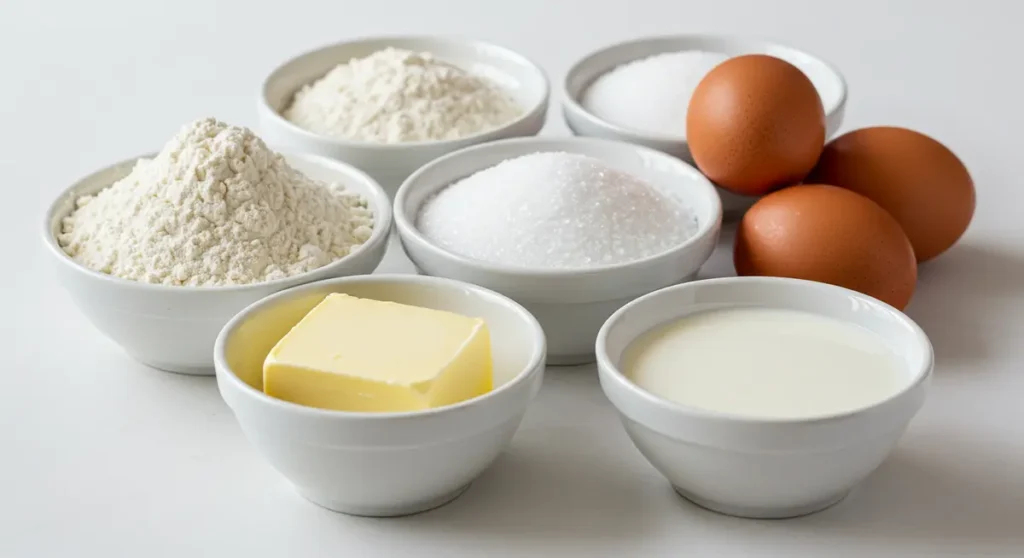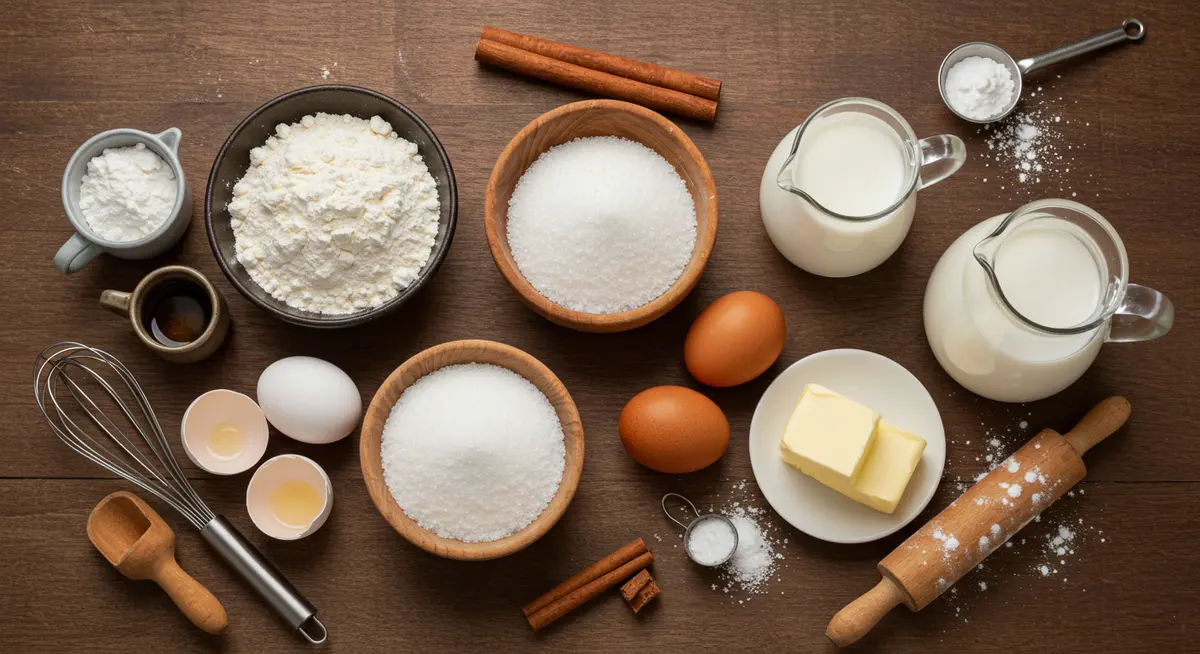Understanding the basic ingredients is vital for successful baking. This article will explore what are the 5 main ingredients in cake, and how they contribute to its texture and taste.
Exploring What Are The 5 Main Ingredients In Cake
A good cake requires a precise combination of elements. Therefore, knowing what are the 5 main ingredients in cake is helpful. This knowledge provides a strong foundation for any baker. Moreover, understanding their function will improve your baking results.
The Five Core Components of a Cake
Cakes are made using a few basic items. Therefore, this section will reveal what are the 5 main ingredients in cake. We will examine each item separately. Additionally, we’ll discuss why they are so important. Furthermore, we will see how each item contributes to the end result.
Flour: The Foundation of a Cake
Firstly, flour is the main structural component of most cakes. It provides the cake’s form. Moreover, it is crucial for the texture. Therefore, using the correct type of flour is very important. Additionally, different kinds of flour will produce different results.
Types of Flour for Cakes
All-purpose flour is the most popular option. However, cake flour is lighter. Therefore, it creates a softer cake. Furthermore, using the right type will influence your cake’s final texture. Consequently, knowing your flour type is very important.
Flour’s Role in Cake Structure
Flour contains proteins that create structure. When mixed with liquid, these proteins form gluten. This gluten provides the framework for the cake. Furthermore, the gluten amount impacts the cake’s tenderness. Therefore, understanding the role of flour is key.
Sugar: Adding Sweetness and More
Secondly, sugar is another key component. Sugar adds sweetness, moisture, and tenderness. Additionally, it aids in browning. Therefore, the right amount of sugar is essential. Moreover, it plays a bigger role than just making the cake sweet.
Types of Sugar in Cakes
Granulated sugar is the most commonly used. However, brown sugar adds moisture and a richer flavor. Moreover, powdered sugar is often used in frosting. Therefore, selecting the right type matters. Consequently, each type of sugar will bring a different outcome.
Sugar’s Effect on Cake Texture
Sugar prevents gluten from becoming too tough. It also helps retain moisture in the baked cake. Furthermore, sugar provides structure by interacting with the other elements. Consequently, sugar has a great impact on the texture.
Fat: Creating Tenderness and Flavor
Thirdly, fat is vital for a tender, moist cake. It enriches the flavor and provides a smooth mouthfeel. Therefore, selecting the correct type of fat is important. Furthermore, fats can come from various sources and each one will bring its own flavor.
Types of Fat in Cakes
Butter is a popular choice. It adds a rich flavor. However, oil creates a more tender cake. Furthermore, shortening also works well. Therefore, each has its advantages. Additionally, the type you use will impact the final taste and texture.
Fat’s Role in Cake’s Overall Outcome
Fat coats the flour proteins. Thus, it prevents too much gluten development. Furthermore, fat helps create a softer, more tender cake. Consequently, the right fat is critical for a good cake.
Eggs: Binding and Leavening
Fourthly, eggs are a key component in many cake recipes. They act as a binder, a leavening agent, and they add moisture. Additionally, they enrich the cake flavor. Therefore, understanding the role of eggs is essential.
How Eggs Bind Cake Ingredients
The proteins in eggs help bind the ingredients together. Furthermore, they create a cohesive structure. Therefore, eggs ensure that your cake holds its shape. Moreover, without this binder, the cake will crumble.
Eggs as a Leavening Agent
Eggs help the cake rise because of the air trapped when they are beaten. Also, egg proteins add air to the batter. Therefore, eggs are very important for creating a light cake. Consequently, eggs aid the rising and texture of the cake.
Liquid: Activating and Combining
Fifthly, liquid is the final important item. Liquid activates the leavening agents. Furthermore, it combines the dry components. Therefore, the type and amount of liquid affect the cake texture. Moreover, it brings all of the elements together into a cohesive batter.
Types of Liquid Used in Cakes
Milk is often used in cakes for added richness. However, water is a common option too. Furthermore, buttermilk gives a slightly tangy flavor. Therefore, each liquid adds different qualities to the final cake. Thus, consider the recipe when choosing your liquid.
The Liquid’s Role in Cake Development
Liquid helps to form the gluten network. Also, it dissolves sugar and baking powder. Furthermore, it creates the batter that will transform into cake. Consequently, the correct liquid amount is very important.
What Are The 5 Main Ingredients In Cake and Their Interactions

The 5 main ingredients don’t act alone. Therefore, understanding their interactions is key to successful baking. Furthermore, each component affects the others. Consequently, the way each ingredient interacts impacts the result.
Flour and Liquid: Forming the Structure
When flour meets liquid, gluten forms. Therefore, this is the base of the cake structure. Furthermore, the liquid hydrates the flour. Consequently, their interaction is critical to the cake’s success.
Sugar and Fat: Creating Tenderness
Sugar and fat work together to make the cake tender. Therefore, the fat coats the flour proteins. Furthermore, sugar interferes with gluten formation. Consequently, this combination ensures a soft texture.
Eggs and Leavening: Achieving Lightness
Eggs introduce air to the batter. Also, this combines with the leavening agents. Therefore, the cake will have a light and airy texture. Furthermore, eggs also help the cake rise. Consequently, this interaction ensures a proper rise.
What Are The 5 Main Ingredients In Cake and Their Alternatives
Sometimes you might need to make substitutions. Therefore, understanding alternatives for each item is useful. Furthermore, dietary needs or preferences may require changes. Consequently, you will need to know your alternatives.
Flour Alternatives for Special Diets
Gluten-free flour blends are suitable for those who avoid gluten. Additionally, almond flour offers a protein-rich option. Therefore, these options cater to different needs. Furthermore, each type brings a slightly different taste and texture. Consequently, choose based on your personal preference.
Sugar Alternatives for Health-Conscious Bakers
Natural sweeteners like honey or maple syrup are a good choice. Therefore, they add flavor and moisture. However, they can affect the texture. Furthermore, it may take some experimentation. Consequently, this will require some adjustments to the recipe.
Fat Alternatives for Dietary Needs
Oils, like coconut or olive, can replace butter. However, they may change the flavor. Furthermore, vegan butter is another option. Consequently, this will need to be taken into consideration.
Egg Replacements for Vegan Baking
Flax seeds or applesauce can act as binders instead of eggs. Therefore, these are great for vegan baking. Furthermore, egg replacers are a readily available alternative. Consequently, choose a suitable option.
Liquid Alternatives for Taste and Texture
Plant-based milks or even juice can be used instead of dairy milk. Therefore, this creates different flavor profiles. Furthermore, using different liquids will change the final result. Consequently, consider your preference.
The Importance of Quality Ingredients
Using good quality items is important. Therefore, fresh and good ingredients will give you the best results. Furthermore, they can greatly influence the cake’s flavor. Consequently, pay attention to the quality of each component.
The Effect of Fresh Ingredients
Fresh ingredients will enhance the final product. Therefore, make sure your items are not old. Furthermore, fresh ingredients give a better taste. Consequently, always choose good ingredients.
Choosing the Right Brands and Types
Different brands can vary in quality. Therefore, research and choose reputable brands. Furthermore, using the correct type of each item will greatly affect the outcome. Consequently, be mindful of your choices.
Conclusion: What Are The 5 Main Ingredients In Cake?
In conclusion, what are the 5 main ingredients in cake are flour, sugar, fat, eggs, and liquid. Each one has a specific role. Furthermore, understanding them allows you to make great cakes. Therefore, master these elements and happy baking. Finally, remember that using quality ingredients is essential.
Ultimately, knowing what are the 5 main ingredients in cake and how they interact is essential. Therefore, having a good grasp of the fundamentals is the secret to a good result. Moreover, each item plays a role. Furthermore, making adjustments may be necessary. Finally, always experiment and learn.
Frequently Asked Questions
What are the 5 key ingredients of a cake?
The 5 key ingredients in a cake are flour, sugar, fat, eggs, and liquid. These items form the foundation. Furthermore, they interact to create the taste and texture of the cake. Therefore, mastering these is important.
What are the 10 ingredients of cake?
While many cake recipes use more than five, the core ten ingredients often include baking powder, vanilla extract, and salt in addition to the basic five: flour, sugar, fat, eggs, and liquid. The additional items enhance flavor and texture.
What is a secret ingredient for cakes?
A “secret” item in cakes is often a liquid such as buttermilk or even coffee. This enhances the cake flavor. Furthermore, it adds moisture. However, it often depends on personal choice and recipe.
What are the 5 main baking ingredients?
The 5 main baking ingredients are flour, sugar, fat, eggs, and liquid. These are the base for most baked items. Therefore, they are important to any baker. Furthermore, understand the function of each.

